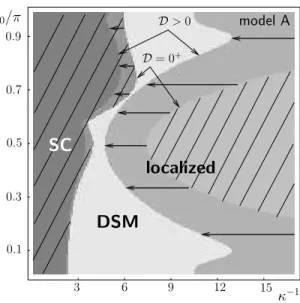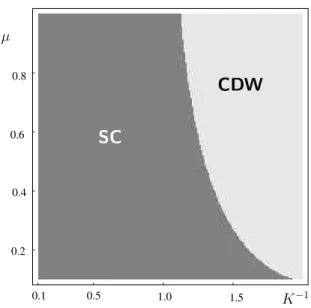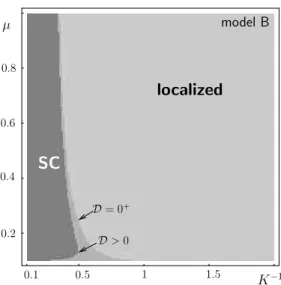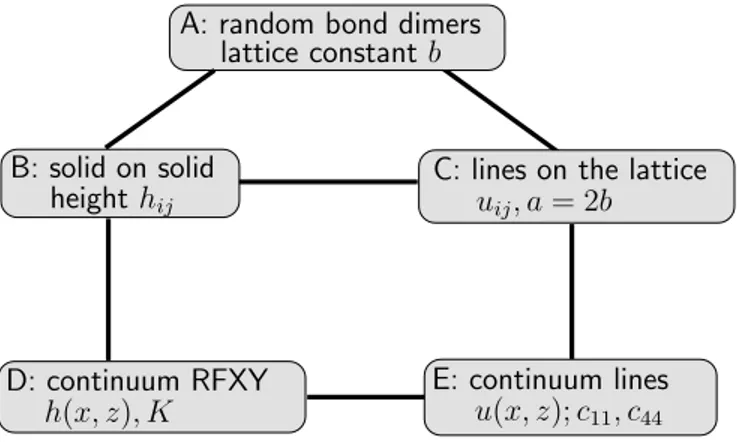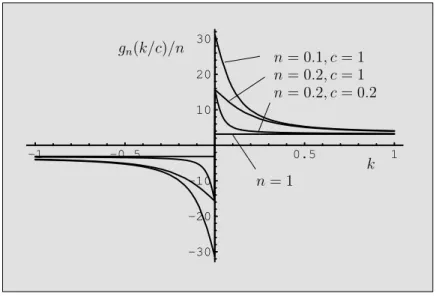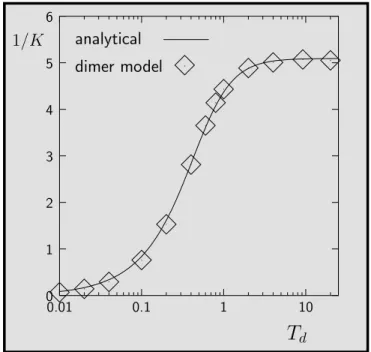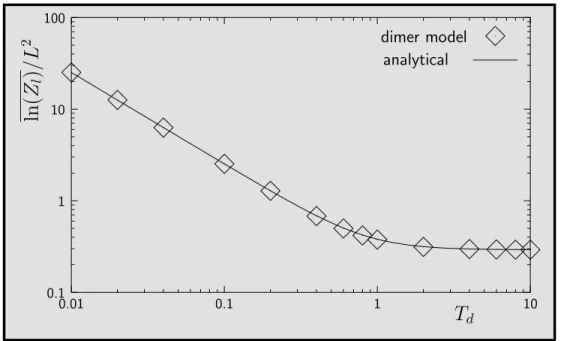Effects of disorder in
striped phases of cuprate superconductors and in
planar vortex lattices
Inaugural-Dissertation zur
Erlangung des Doktorgrades
der Mathematisch-Naturwissenschaftlichen Fakult¨at der Universit¨at zu K¨oln
vorgelegt von
Simon Sebastian Bogner
aus N¨urnberg
2003
Dr. T. Emig Tag der m¨undlichen Pr¨ufung: 11. Juli 2003
Abstract. —Effects of disorder on planar periodic structures in superconductors are examined in the present work. In part one we analyse the role of impurities in the striped phases of cuprate high- temperature superconductors. The geometrical degrees of freedom of the combined charge and spin superstructure in the two-dimensional (2D) copper-oxide planes are first discussed. Pinning by the atomic lattice – which might give rise to commensuration effects – is irrelevant on large length scales in the presence of quenched disorder. As a consequence, the stripes have divergent displacement fluctuations and topological defects are present at all temperatures, implying short-ranged positional order of the stripe array with a finite correlation length even at zero temperature. Lock-in phenomena can exist only as crossovers but not as transitions. These results are in agreement with the glassy nature of stripes observed in experiments.
Secondly, we study the effect of disorder on coupled planar arrays of Luttinger liquids (LLs) as a model for the electronic degrees of freedom of the stripes. In the framework of a renormalisation group analysis, we find that weak inter-LL charge-density-wave couplings are always irrelevant as opposed to the pure system. By varying either disorder strength, intra- or inter-LL interactions, the system can undergo a delocalisation transition between an insulator and a strongly anisotropic metallic state with LL-like transport. The delocalised state can exist other than in one dimension even for a purely repulsive interactions and it is characterised by short-ranged charge-density-wave order, quasi-long-ranged superconducting order along the stripes and short-ranged superconducting order in the transversal direction.
In part two the random (1+1)-dimensional fluxline lattice as a model system for vortex glasses (VG) is examined. Using the recently found exact Replica Bethe Ansatz solution [EK01] for a special vortex interaction, we argue against the existence of the transition to a thermally unpinned phase above the VG. The argument is generalised to arbitrary repulsive interactions via the mapping to one- dimensional repulsive fermions. A small window for the transition sharply below the superconducting critical temperature is opened by the introduction of a finite persistence length of a single vortex line.
In the phenomenologically related random-field XY model the transition under debate is present but does not leave any signature in the free energy as we calculate in a sideline of the reasoning.
Finally, the relation of the vortex system to the random-bond dimer model is explored in detail. The latter can be simulated with a recently developed polynomial algorithm at a precision far beyond any previous Monte Carlo approach. Data from simulations, which are provided by the collaborating group of C. Zeng (Washington, D.C.), and theory do not only show qualitative but also excellent quantitative agreement for a wide range of observables: the large scale lattice stiffness; the average free energy, internal energy and entropy; moments of the disorder distributed free energy; specific heat. The special model character of the planar VG as a genuine glassy and yet in many aspects solvable system is highlighted.
Contents
A. Introduction 7
1 Striped phases in cuprate superconductors . . . . 7
2 Planar vortex systems . . . . 8
3 Relations and methods . . . . 10
B. Striped phases, the geometrical degrees of freedom 12 1 Introduction, the phenomenology of stripes . . . . 12
2 Model, competing mechanisms . . . . 17
3 Classical limit . . . . 19
3.1 Periodic potential only . . . . 19
3.2 Pinning potential only . . . . 20
3.3 Complete potential . . . . 22
4 Adding quantum fluctuations . . . . 24
4.1 At zero temperature . . . . 25
4.2 At finite temperature . . . . 27
5 Summary and discussion . . . . 28
C. Striped phases, the electronic degrees of freedom 31 1 Introduction, possible 2D non-Fermi-liquid metal and the role of disorder . . . . 31
2 The general model: coupled one-dimensional electron gases . . . . 32
3 Renormalisation . . . . 34
4 Phase diagrams, generic features . . . . 37
4.1 Model A: interaction yielding a rich phase diagram . . . . 38
4.2 Model B: realistic interaction . . . . 40
5 Correlations . . . . 42
6 Discussion and outlook . . . . 43
D. Planar vortex lattices 45 1 Introduction . . . . 45
2 Absence of a glass transition in the (1+1)-dimensional line lattice . . . . 47
2.1 Mapping to the XY model and the non-crossing condition . . . . 47
2.2 The free energy of the XY model at the glass transition . . . . 49
2.3 Shortcomings of the elastic approximation . . . . 55
2.4 Non-crossing interaction and disorder: the exact free energy . . . . 59
3 The random-bond dimer model and the (1+1)-dimensional line lattice . . . . 66
3.1 The models and the mapping . . . . 66
3.1.1 Vortex system . . . . 66
3.1.2 Dimer model . . . . 66
3.1.3 Relation . . . . 67
3.2 Thermodynamics . . . . 74
3.2.1 Large scale equivalence . . . . 74
3.2.2 Free energy, internal energy and entropy . . . . 76
3.2.3 Higher moments . . . . 78
3.2.4 Response functions . . . . 84
4 Conclusion . . . . 97
E. Notes on the Bragg glass 98 1 List of extensions on formerly published work . . . . 98
2 Correlation functions from the RG results . . . . 99
F. Appendix 102 1 Bosonisation . . . 102
2 A technical problem: real- vs momentum-space renormalisation for dual fields . . . . 106
2.1 Action and free correlations . . . 107
2.2 Flow equations in momentum-shell RG . . . 109
2.3 Real-space RG . . . 109
2.4 Conclusion . . . 113
3 Spin wave contribution to the RFXY free energy . . . 116
4 Correlated random walk . . . 116
5 Annealed average of dimer and vortex free energies . . . 116
References 124
Dank 126
Zusammenfassung 128
Erkl¨arung 130
7
A. Introduction
1 Striped phases in cuprate superconductors
High-temperature superconductivity (HTSC) was discovered in 1986 [BM86]. To the present day, a satisfactory understanding of the pairing mechanism in the new material classes has not been achieved. Early hopes for the designability of compounds with ever higher transition temperatures could not be fulfilled. Still, the intense research has greatly advanced the understanding of strongly correlated fermions and made this one of today’s thriving fields in condensed-matter physics. The copper-oxide (CuO2) planes common to all the important high-Tc compounds, the ’cuprates’, have been identified as the basic functional building block. The rich phase diagram of HTSC is believed to emerge upon hole doping from the physics of these antiferromagnetic CuO2 layers, which are often described by the very reduced paradigm model of highly correlated electrons, the Hubbard model. Theoretically, a new ordering phenomenon in doped antiferromagnets had been predicted [Sch89, ZG89, Mac89, EKL90]: the one-dimensional periodic accumulation of the free charges in
’rivers’ that simultaneously act as anti-phase boundaries in the surrounding antiferromagnet. After the first experimental observation of these one-dimensional superstructures [TSA+95] the field of stripes physics in the cuprates began to flourish. Not only is the existence of stripes by now exper- imentally proven in all the important compound classes, their relation to superconductivity is also largely debated. While the static, originally detected stripe structures quite clearly suppress super- conductivity, the dynamically fluctuating variant plays an essential role in a class of – still – rather speculative model mechanism for high-temperature superconductivity [KFE98]. The focus of the present work is neither on the microscopic mechanism of the formation of stripes nor on the mech- anism of superconductivity. We rather explore the influence of another key ingredient in real-world materials, which is, moreover, generic in doped compounds: disorder. In a first part (Chapter B), the structural properties of a stripe ordered phase are analysed. The preformed stripes are treated as collective quantum objects. Both the underlying periodic lattice and random impurities work against thermal and quantum fluctuations in the effort to pin the stripe array. The periodic potential tends to order the array while disorder pinning roughens the structure. The question in this multiple com- petition is which mechanism will prove most efficient. A motivation of such an analysis comes from the observation of particularly stable, static stripe structures at certain doping levels that correspond to well-defined stripe spacings [MSFS88]. A lock-in of the stripe superstructure in the underlying periodic atomic potential seems possible. On the other hand, glassy features of the superstructure have also been observed, which suggests a dominant role of disorder [TIU99, DGS+00]. The situation in the present model is complicated with respect to roughening phenomena in disordered classical elastic systems [EN97, EN98] by the presence of quantum fluctuations. On a technical level, the quantum nature can be coded in an extra imaginary time dimension in the Feynman path integral
approach. Disorder is then correlated in time direction which has always prevented a closed renor- malisation group (RG) analysis [Bal93]. In order to avoid the known obstacles our approach lies in a suitable successive ’switching on’ of mechanisms. The effect of the latest mechanism on the phase diagram one step earlier is analysed with a combination of scaling and RG arguments. Eventually, having chosen a convenient order of steps, we arrive at the qualitative phase diagram for the full model. Disorder shows to be dominant on largest scales while lock-in effects can only be seen in crossover behaviour and cannot establish a phase of their own. A detailed overview of experimental observations in the cuprates – and related nickelate systems – and of the phenomenology of stripes is given in the introductory section of this first part on stripes.
In the second part (Chapter C) we turn to the so far neglected internal degrees of freedom of the
’rivers of charges’. In the limit of sharp distinction between charge-carrier-free regions and the charge stripes, these stripes may be considered as one dimensional electron gases (1DEG). They interact internally, described in the Luttinger liquid picture [Hal81a], and from stripe to stripe by the electron Coulomb repulsion. The coupling to spin degrees of freedom in the embedding antiferromagnet as well as inter-stripe superconducting order-parameter coupling opens a whole variety of possible emerging phases depending on the actual coupling parameters. A model calculation by Emery et al. [EK93, EKZ97] showed that the antiferromagnetic environment may induce a gap in the spin sector on the stripes. As a consequence, one-particle hopping between the stripes is no longer necessarily the dominant inter-stripe coupling. A novel two-dimensional non-Fermi liquid seems to be at least possible. This as a starting point, a series of publications tried to give phase diagrams of coupled Luttinger liquids as a model for cuprate superconductors [EFKL00, MKL01, VC01]. The most spectacular consequences are naturally emerging superconducting phases and also a phase where both of the strong, competing instabilities – charge-density-wave coupling and the superconducting order-parameter Josephson coupling – are irrelevant. This ’sliding Luttinger liquid’ or ’smectic metal’
would be the realisation of a two-dimensional metallic non-Fermi liquid. The caveat is, however, as big as the ’smectic metal’ portion of the phase diagram is small. Only very arbitrary finetuning in the on-stripe and inter-stripe interactions which can hardly be related to the original Coulomb potential leads to the remarkable results. In our contribution to the model, we examine the influence of on-stripe disorder on the suggested phase diagrams, both for the finetuned interaction necessary to obtain the smectic metal and for a more realistic interaction derived from the screened Coulomb potential. In the latter case, the phase diagram looks less colourful with no smectic metal present.
Generically, disorder reduces the superconducting phase and replaces all of the charge-density-wave phase by a disorder-localised phase with no translational symmetry. The smectic metal survives disorder localisation in the finetuned model in asmallpart of itssmallfraction of the phase diagram as the strongly modified ’disordered stripe metal’ (DSM). Other than in the one-dimensional case, delocalisation is possible even for purely repulsive interactions. The delocalised state is characterised by short-ranged charge-density-wave order, the superconducting order is quasi-long-ranged along the stripes and short-ranged in the transverse direction.
2 Planar vortex systems
The effect of disorder on a periodic structure in superconductors – the theme is the same when the glass phase of planar vortex arrays is examined in the second part of the present work. The Abrikisov
A.2 Planar vortex systems 9
or mixed phase of type-II superconductors – and the high-temperature superconductors are strongly- type II – is of eminent technological relevance. An external magnetic field enters the material in the quantised form of fluxlines which order ideally in a regular lattice. Any transport current in the superconductor will induce such a field, rendering fluxlines ubiquitous in practical situations.
Disorder plays under these circumstances not a destructive but a constructive role. Impurities – unavoidable anyway – are welcome to pin the vortex array and prevent dissipation from fluxline motion transverse to the transport current. The nature of the vortex state is not left unchanged by disorder. The translational order of the regular lattice is destroyed in what is then a vortex glass (VG). This phase is fascinating from a theoretical point of view also as a model glass system, on par with the extensive field of spin glasses [BY86]. Translational symmetry is broken, metastable states slow down the relaxation and large barriers in between dominate transport characteristics. The energetical favourability of topological defects will depend on the strength of thermal and disorder fluctuations. They will render the phase diagram even richer with the topologically ordered Bragg glass at weak disorder and a possibly multistep melting behaviour [Kie98, BMS+01, AKM+01].
The planar vortex array is a compromise model in a good sense. The reduction of the dimension transverse to the vortex lines may seem artificial considering the technological relevance. However, the system is now simple enough to be approached very successfully in the threefold way of modern physics: (i) experimentally, (ii) analytically and (iii) by numerical means. Since long, theory has predicted the planar vortex array to be a generic glassy system, despite the dimensional simplification.
The mapping to the random field XY (RFXY) model [Fis89] reveals the existence of a low-temperature disorder-dominated phase [CO82], with all the signatures in static and dynamic correlations of a glass [CS96]. Recently, in a prominent experiment with a thin specimen of a conventional superconductor, such a planar vortex glass has been investigated [BAP+99]. As for the numerical side, an extensive literature has grown on Monte Carlo simulations, mainly of the related RFXY model [BH94, MMRL95, CS95]. Only lately the discovery of the relation to a model of statistical combinatorics, the random- bond dimer model, which can be simulated with polynomial algorithms, has put the planar vortex array in a unique position in the field of vortex (and in many senses related spin) glasses. System of linear sizes up toL= 512 can be treated on desktop computers with numerical exact algorithms [ZLH99]. Even the quantitative testing of scaling approaches like the droplet picture of spin glass theory [FH88] seems within reach.
Our contribution is twofold. First, we critically examine the possible transition of the planar vortex glass to an unpinned phase at higher temperatures as implied by the often used mapping to the RFXY model (Section D.2). New exact results for the free energy of the vortex system with a contact interaction that prevents line crossing (’noncrossing only’ vortex interaction) [EK01] rule out the transition to the high-temperature phase. We stringently extend the argument to the generic case for a repulsive interaction, a result that had been previously suggested [NLS91] but also often debated. Sharply below the superconducting transition, there is
In a sideline of the reasoning the analytic behaviour of the free energy of the RFXY model throughout the transition, which this system does undergo, is shown.
The second part (Section D.3) is the fruit of a collaboration with the group of Chen Zeng at George Washington University, who study numerically the random-bond dimer model and its direct link to the vortex model. Once the details of the mapping have been clarified, the comparison of the analytical results from Ref. [EK01] to so far unpublished simulations is very gratifying. Not only
for the large-scale behaviour like correlation exponents but also for a wide range of thermodynamic quantities, including response functions and even moments of the disorder distributed quantities, the agreement between theory and simulation is very good. Concerning the latter quantities this is even more surprising as, a priori, one could have imagined a strong dependency on microscopic details, which, of course, differ from the continuum model to the lattice dimers. The benefit is two-directional. On the one hand, the validity of the analytical Bethe Ansatz results in the replica framework are clearly confirmed. At least for the delicate part of the analytical continuation in the replica index, this may not have been anticipated universally. On the other hand, the dimer model is shown to simulate precisely the disordered vortex system onalllength scales. Questions regarding the vortex glass that cannot be addressed analytically may hence be answered numerically in the dimer model context. To be a bit more speculative, in view of the large number of relations between tiling problems and condensed matter systems [MS02] it might prove profitable in other contexts to have solved with the Bethe Ansatz results a random dimer model exactly.
For a more detailed introduction to the models and the literature we refer to the introductory sections of Chapter D.
3 Relations and methods
The links between the two main parts of the present thesis are manifold. Beyond the relation of the physical systems, all type-II superconductors, and the common emphasis on disorder effects, there is a methodological brace. In the two-dimensional plane, superstructures with a one-dimensional periodicity are subject to the disordering influence of impurities. The problem falls into the class of ’disordered elastic media’ that has prospered over the last 15 years in a fruitful interplay with the development offunctionalrenormalisation tools [Fis86, NS00, SD00, LWC02]. Prior to rigorous renormalisation group methods comes the use of qualitative scaling arguments in order to clarify the broad large-scale picture in situations with competing mechanisms. The use of both will go hand in hand throughout the following chapters. We also take advantage of the possibility given by the Feynman path-integral approach to quantum mechanics. A quantum statistical physics problem can be rewritten as a classical problem with an extra (imaginary time) dimension. In Chapters B and C, we go the way from quantum mechanics to classical physics, while in Chapter D, the two- dimensional classical line system is mapped onto interacting fermions in one dimension. Also, the method of bosonisation, that allows to write one-dimensionalinteractingfermion systems in the guise of a classical two-dimensionalelastic manifold is used two-directional. In Chapter C the interplay of stripe electronic degrees of freedom with disorder is examined in terms of bosonised, classical fields while in Chapter D, when the possibility of a glass transition in the vortex array is analysed, the mapping of the lines to fermions – and simple results from bosonisation theory there – prove helpful. For the ease of the reader, the presentation of known results from the literature may appear repeatedly if needed at considerably distant points of the thesis.
Numerical methods had to be used at two points. The phase diagrams in Chapter C rely upon solving a large number of integrals numerically, while in Section D.3 the very ill-conditioned Bethe Ansatz integral equation has to be solved numerically in order to extract higher moments of disorder- distributed thermodynamical quantities.
Chapter E briefly states the ’round up’ work that had been done on the field of the author’s diploma
A.3 Relations and methods 11
thesis, the ’Bragg glass phase in impure type-II superconductors’. A long version of the analysis, whose results had already been published, was produced. It may illustrate nicely the applicability of functionalrenormalisation tools, as mentioned above, to disorder vortex physics.
B. Striped phases, the geometrical degrees of freedom
1 Introduction, the phenomenology of stripes
During the last decade evidence emerged from theoretical work [Sch89, ZG89, Mac89, EKL90] and from experiments on cuprates [CAM+91, MAM92, TSA+95, DMD98] and closely related nickelates [HLZ+92, CCC93, TBSL94, LC97] for the existence of striped structures within theMO2(M =Cu, Ni) planes. These stripes are highly correlated states of holes which are introduced into the planes by doping and which order into a unidirectional [MDDH00] charge-density wave (CDW, wave length a) that may be accompanied by a simultaneous spin-density wave of period 2a in the sublattice magnetisation of the antiferromagnetic metallic spins [TBSL94, KE96, ZKE98]. Qualitatively, one may think of stripes as parallel strings of holes that constitute an antiphase boundary for spin order, see Fig. B.1.
Particular interest in these stripes – see the rapidly growing literature in the field, Fig. B.2 – arises from the possible interplay [EK93] between stripes and superconductivity, In Fig. B.3 a phase diagram of the classical HTSC material is sketched. Fig. B.4 collects stripe signatures for the same material that can be seen in a wide portion of the phase diagram both in the superconducting and in the normal phase. It is important to distinguish between “dynamic” and “static” stripes. While there is evidence that superconductivity can coexist with both dynamic [CAM+91, MAM92, MD99] and static [TAI+97, KHM+99] stripes, static stripes tend to suppress superconductivity [CHM+91, NU92, EKZ97] in contrast to dynamic stripes. Therefore the study of the structure and dynamics of stripes is of principal importance.
In Fig. B.5, typical experimental evidence from neutron scattering for a periodic superstructure is shown. The plot is taken from the classical paper by Tranquadaet al. The superstructure peaks are given in reciprocal lattice vector units with respect to the orthorhombic unit cell of the CuO2-plane.
If the four-fold rotation symmetry in the plane is not broken, the tetragonal unit cell may equally be used, see Fig. B.6. Stripes in the cuprates were first seen in the La2−xSrxCuO4 class of materials.
Their detection in the important YBa2Cu3O7−δ and Bi2Sr2Can−1CunO4+2n+δ families was more difficult, but by now it has been compiled a large amount of evidence for stripes in all major material classes by a wide range of experimental techniques, see Table B.1. La2−xSrxCuO4 is a n = 1 material, i.e., it has one CuO2-plane per unit cell and a fairly low maximum critical temperature Tc = 40K compared to YBa2Cu3O7−y (Tc = 93K) and Bi2Sr2Can−1CunO4+2n+y (Tc = 100K).
The latter two are n≥ 2materials and are doped interstitially by extra oxygen in contrast to the substitutional strontium doping in the case of La2−xSrxCuO4. See Figs. B.7, B.8 for a sketch of the
B.1 Introduction, the phenomenology of stripes 13
structure of two representative compounds.
(i) (ii) (iii)
SDW-period2a CDW-period a
Fig. B.1: Sketch of the charge and spin density wave in the CuO2-planes, sideview; circles stand for the Cu-sites with thickness proportional to hole concentration. (i) represents the charge modulation, (ii) the antiferromagnetic order with phase shifts at the charge stripes; (iii) illustrates the periodic modulation in the staggered magnetic field (SDW) due to the phase shifts with period2a.
#publicationson’stripes’
year Phys. Rev. Lett.
arXiv.org/cond-mat
40
2002 2000 1998 1996 1994 140
1992 1990 1988 120 100 80 60
20
Fig. B.2: Appearance of keywords ’stripes’ and ’striped’ in title and abstract of publications in Physical Review Letters and in preprints oncond-mat; data for 2003 are extrapolated from the first quarter of the year. Note that the Phys. Rev. Lett.-data contain a background of about 3 publications per year from the field of optics rather than highly correlated electronic systems.
Various phenomenological pictures have been developed for the theoretical description of stripes.
While charge and spin order are naturally described within a Landau theory [ZKE98], the as- pect that stripes act as magnetic domain walls suggests to describe them as string-like objects [ZHvS96, MDHC98]. In the ideally ordered case these strings form a periodic array. Dynamic fluctu- ations are generated by thermal and quantum effects, whereas potentials tend to suppress dynamic fluctuations while they may reduce or increase static conformations of the stripes.
In such phenomenological models, the crystalline structure of the underlying atomic lattice has to
Fig. B.3: Temperature vs doping phase diagram of the high-Tc compound La2−xSrxCuO4; from [KBB+92].
Fig. B.4: Charge (ch) and spin (m) order in the HTSC phase diagram; note the higher en- ergy scale for charge order as compared to mag- netic ordering; also note the simultaneous peak in stripe order and dip of superconducting response;
from [IUT+00].
be taken into account by a periodic potential with period b in the direction perpendicular to the stripes. Such a potential tends to increase the positional order of the stripe array since is can be the source of lock-in effects [TSA+95, NW96, EKZ97], see Fig. B.9 where the structural transition in Nd-La2−xSrxCO4 precedes the appearance of static stripe order. Depending on the crystalline phase of the material [low-temperature orthorhombic (LTO) or low-temperature tetragonal (LTT)]
and on the direction of the stripes with respect to the crystal axes, the ratio between the period b and the distance of nearest neighbours can vary.1 In the cuprates the orientation of the stripes can change with doping: in La2−xSrxCuO4 the stripes were found to lie “diagonal” in the elementary CuO plaquette for low doping, while they rotate by 45o into a “collinear” state for larger doping when the material becomes superconducting [WSE+00, MFY+00], see Fig. B.10. In the nickelates, the stripes appear to be diagonal in general.
In addition to such a periodic potential, the spatially inhomogeneous distribution of dopants provides a disorder potential for the stripes because of the (screened) Coulomb interaction between dopants
1Denoting the distance between nearest metal neighbours withd and neglecting the tilt of the oxygen octahedra, one hasb/d= 1for collinear stripes andb/d= 1/√
2for diagonal stripes. Although the octahedra tilt increases the period of the atomicstructurein the LTT and LTO phases to twice its value, the period of the stripepotential remains the same for symmetry reasons: the atomic structure is modulated only by out-of-plane displacements (alternating “up” and “down”) of the oxygen atoms. These displacements do not double the period of the potential since the stripe energy is not sensitive to the direction of the out-of-plane displacement.
B.1 Introduction, the phenomenology of stripes 15
Fig. B.5: Typical superstructure peak in neutron scattering; from [TSA+95].
x
x x
x x x x x x
x x
x
orthorhombic
tetragonal '5.3˚A
'3 .8˚A
Cu O
Fig. B.6: Orthorhombic vs tetragonal unit cell of theCuO2-planes.
method length scale time scale
neutron scattering couples to spin density elastic 100˚A 10−9–10−14s
inelastic ∆E'meV∼4×10−12s
resonance relaxation of excited internal or implanted states is observed
NMR local 10−3s nuclear magnetic resonance
µSR ” 10−4–10−6s muon spin resonance
ESR ” 10−6–10−10s electron spin resonance
NQR ” static quadrupole res. (→electric field)
X-rays 0.1-10µm 10−13–10−14s couples to charge density ARPES photo emission; probes Fermi surface, quasiparticle spectrum transport conductivityσ, Hall coefficient RH, thermoelectric effect
STM tunneling microscopy; controversial interpretation [HML+02, HEKK02]
Table B.1: Experimental techniques and their characteristics.
and holes. For low enough temperatures, these dopants can be considered as quenched. However, not all dopants will contribute to the disorder potential. While substitutional dopants (such as Sr in La2−xSrxCuO4) are essentially randomly distributed, interstitial dopants (such as oxygen) may partially organise themselves in homogeneous layers parallel to the CuO2-planes (this behaviour is called “staging”, see [WLK+97]). At higher temperatures (≈102K), interstitial dopants may be- come mobile and act as annealed disorder, while substitutional dopants are still quenched.
Fig. B.7: Conventional unit cell of La2CuO4, showing lanthanum ions and CuO6 octahedra. Oxygen atoms at the ver- tices of the octahedra are not shown. The unit cell contains two formula units.
Fig. B.8: Conventional unit cell of YBa2Cu3O7, again oxygen atoms are not shown; one formula unit per cell.
Fig. B.9: Structural phase transition in Nd- La2−xSrxCuO4 and evolution of superstructure
signals; from [TSA+95]. Fig. B.10: Sublattice resonance as a function of doping; the stripe pattern rotates by45o at the critical dopingx'0.05. From [MFY+00].
Pinning by the periodic potential is of particular interest since lock-in effects might explain the special role of certain values for the stripe spacing. In the cuprate system La2−xSrxCuO4 a linear relation δ≈x between the mismatchδof magnetic Bragg satellite peaks and the hole doping concentration x is observed from zero doping up to a saturation at x ≈ 0.12 [YLK+98, MFY+00]. Since the mismatchδis related to the lattice and CDW periods viaδ=b/2a, it allows for a natural explana- tion [TSA+95] of the “x= 18-problem”, which was originally observed in La2−xBaxCuO4[MSFS88]:
Since at δ = 18 the periods of the CDW and the Cu spacings have an integer ratio p:=a/b = 4
B.2 Model, competing mechanisms 17
this saturation could be a commensuration effect.2 Similarly, the nickelate system La2−xSrxNiO4+y
shows anomalous thermodynamic behaviour at the valuesp= 2,3[CHC+94, RGC+96] which seem to be stable over certain respective ranges of the hole concentrationx+ 2y [CCC93]. Even more, evidence was reported [TBSL94] for plateaus of the mismatch as a function of temperature at rational valuesδ= 223, 365 in La2NiO4.125.
On the other hand, the stripe array can also be pinned by disorder [TIU99, DGS+00]. Therefore it is important to take a closer look at the competitive pinning by the periodic atomic lattice and by disorder in order to understand to what extent lock-in effects can persist. A first step in this direction was made by Hasselmannet al. [HNMD99] who focus on a singlestripe. However, since a single stripe and a stripe array differ in dimensionality one expects qualitatively distinct behaviour of the response of the system to disorder.
The purpose of the analysis in this chapter is to determine the effects of periodic and disorder poten- tials on thestructuralorder of the two-dimensional stripe array on large scales. The internal electronic degrees of freedom are not probed in the present context. We assume them to be integrated out and to determine only the large scale parameters of the stripe description as fluctuating objects. In the next chapter, the point of view will be reversed and the internal degrees of freedom will be in the focus.
The outline of the chapter is as follows. In Section 2 we establish an elastic model for the quantum stripe array with periodic and pinning potentials. The effects of these potentials are discussed in Section 3 in the classical limit. In Section 4 we demonstrate the irrelevance of quantum fluctuations.
Our conclusions are drawn in Section 5 where we discuss the relation of our work to previous work, the role of topological defects and implications for experiments.
2 Model, competing mechanisms
We describe the stripe system as an array of interacting quantum strings. The strings are assumed to be aligned in y-direction and to have an average spacinga in x-direction. In the following we ignore topological defects in the array, the role of which will be discussed in Section 5. Then the stripe array can be considered as an elastic system. The displacement fieldurepresents a bosonic collective mode of the electron system. Its fluctuations are governed by a (“reduced”) dynamic action [ZHvS96, MDHC98, HNMD99]
S = 1 Z /T 0
dτ Z
d2r µ
2(∂τu)2+H
. (2.1)
τ is the imaginary time and it is setkB = 1. We identifyr= (x, y), µ is a mass density and the HamiltonianHhas a contribution from the elastic energy
Hel = Z
d2r γ 2(∇u)2
with a stiffness constantγ which includes the line tension of the strings as well as their interaction.
The main contribution to this interaction will stem from the Coulomb interaction between the stripes,
2Note that our usage of the notions commensurate and incommensurate follows the traditional usage in the context of commensurate-incommensurate transitions [Bak82, LNP92]. We distinguishincommensurabilityfrom amismatch δof Bragg peaks in the structure factor, whereas in the stripe literature incommensurability is used synonymously to mismatch. Our notions allow to distinguish incommensurate and commensurate states with finite mismatch.
but it will also have contributions of entropic nature. These will, however, differ substantially from the 1+1 dimensional case discussed in later chapters, see [Zaa00] and references therein. We therefore will avoid in the following analysis arguments based on the numerical value of the stiffness constants, even when the classical 1+1 dimensional limit of our 2+1 dimensional model is discussed. A further contribution to the stiffness arises from a crystal field that aligns the stripes iny direction. A priori, the stiffness can be anisotropic with an elastic energy density ∝γx(∂xu)2+γy(∂yu)2. To simplify the analysis, such an anisotropy can be removed by rescaling the y coordinate. Then the effective isotropic stiffness constant is related to the original anisotropic constants throughγ=√γxγy. Note that γx is dependent on the stripe spacinga, i.e., on doping. With increasing distance a between the stripesγ will shrink.
We will examine the coupling of the stripe array to the periodic potential U(x) generated by the atomic structure as well as to a random potentialV(x, y)due to the interaction between the holes and the dopants which may be considered quenched at low temperatures. The corresponding energy contributions read
HU = Z
d2r ρ(r)U(x), HV = Z
d2r ρ(r)V(x, y) (2.2) in terms of the stripe density
ρ(r, τ)' 1 a
n X
m
eiQm[x−u(r,τ)]−∂xu(r, τ)o
(2.3) whereQm:= 2πm/aare reciprocal lattice vectors of the stripe array. The elastic and disorder pinning energies of the stripe array are similar to those of vortex lines in planar type-II superconductors. A recent review of the latter system can be found in Ref. [NS00].
U is assumed to be periodic,U(x) =U(x+b), with a periodb < a(the modulation along the stripes is negligible for our purposes). For simplicity we takeU(x) as an even function (this restriction is for the simplicity of our analysis but not essential for the results)
U(x) =−X
n≥1
Uncos(pQnx)
withp >1. We assume that the random potentialV(x, y)is Gaussian distributed with zero average and a variance
V(r)V(0) = ∆
√2π ξe−x2/2ξ2δ(y) with a correlation lengthξ and a weight∆.
Subsequently we will establish the global phase diagram for the total system with a partition sum Z =
Z
D[u] e−S.
Since the system without pinning provides an important reference point we start with a brief discussion of thermal and quantum fluctuations of the displacement. There is a characteristic length scale
`T :=p 2
γ/T2µbeyond which thermal fluctuations dominate over quantum fluctuations. A related temperature scaleTa:=p 2
γ/a2µis defined by the coincidence`T =a. In terms of these scales,
B.3 Classical limit 19
the displacement fluctuations in systems with a large sizeL`T are obtained as
hu2i '
T 2πγlnL
a forT Ta,
T 2πγln L
`T
+
2a√πγµ forT Ta. (2.4)
Thus, while the unpinned stripe array is flat (i.e., hu2i is finite for L → ∞) at T = 0, it is logarithmically rough (i.e.,hu2i ∝lnLforL→ ∞) at any finite temperature.
3 Classical limit
For the analysis of the effects of the potentials it is convenient to examine the various limiting cases defined by the relative strength of thermal fluctuations, quantum fluctuations, periodic pinning and disorder pinning. We start from the consideration of the classical limit
→ 0 acting on the
appearing explicitly in Eq. (2.1) but not on possible implicit dependences of other model parameters.
In this limit temporal fluctuations become negligible and one has to examine the system governed by the Hamiltonian
H = Hel+HU+HV.
In the absence of the potentialsU andV thermal fluctuations lead to an average displacement that diverges logarithmically with the system size L [see Eq. (2.4) for Ta = 0] which means that the stripe structure has only quasi-long-range order in the position of the stripes.
3.1 Periodic potential only
To analyse the relevance of a periodic pinning potential we focus on commensurabilities of low order with integer p. In this case the stripe structure can lock into the periodic potential at low temperatures while it unlocks at large temperatures. The transition between these two states is analogous to the roughening transition of crystal surfaces. We follow the standard analysis of the roughening transition (see Ref. [Noz92] and references therein) in order to obtain the transition temperatureTR. Combining Eqs. (2.2), (2.3) and (2.4) we find an average potential energy
hHUi ' −L21 a
X
n≥1
Unexp −p2Q2nhu2i/2
(3.5a)
' −L21 a
X
n≥1
Un
L a
−p2Q2nT /4πγ
(3.5b)
for an infinitesimally weak periodic potential. The lowest harmonic n= 1gives the most relevant contribution to this energy. The stripes are locked when the average potential energy does not vanish in the limitL→ ∞, i.e., for temperatures below
TR= 2γa2 πp2 .
The transition temperature increases with increasing strength of the potential sinceγis renormalised to larger values. The effective parameters on large length scalesL=ael are described by renormal- isation group (RG) flow equations [Noz92]
d
dlU1 = (2−πp2T
a2γ )U1, (3.6a)
d
dlγ = A2π4p2
γa2 U12, (3.6b)
with a temperature dependent coefficient A which is of order one near the roughening transition.
These equations lead to the phase diagram sketched in Fig. B.11. The case with non-integer p
x x x x x x U1
γa2
2
p2 πT
γa2
Fig. B.11: Schematic representation of the renormalisation-group flow near the roughening transition accord- ing to Eqs. (3.6). The line of crosses represents fixed points where the periodic potential is irrelevant and the stripes are not locked. The dashed line is the phase boundary between the locked and unlocked phase.
Arrows indicate the RG flow.
involves the analysis of higher order commensurable states or incommensurable states. In such cases the periodic potential is less relevant than in the low order commensurate cases examined above.
Since we find later that the periodic potential is irrelevant in the presence of disorder, for integer p≥2this will be true also for non-integer p. For more details on commensurate/incommensurate systems the interested reader is referred to Refs. [Bak82, LNP92].
3.2 Pinning potential only
In order to discuss the relevance of disorder pinning, we start from the HamiltonianHV as given in Eq. (2.2), discard rapidly oscillating terms that are irrelevant on scales much larger thanaand keep only the most relevant term m= 1in the sum over harmonics for the density (see Ref. [NS00] or [BEN01] for intermediate steps). After averaging over disorder we find the effective replica pinning Hamiltonian
HrepV ' X
αβ
Z d2r
−γ2σ
2T ∇uα∇uβ
− ∆
a2T cos2π
a [uα(r)−uβ(r)]
(3.7)
B.3 Classical limit 21
Disorder couples to the ∂xu term in the density Eq. (2.3) as a random field and gives rise to the first term in Eq. (3.7) with a valueσ = aπ∆2γ2. (Note that strictly speaking this term should contain only ∂xuα∂xuβ in the unrenormalised Hamiltonian; the form written in Eq. (3.7) anticipates that renormalisation generates a random field coupling tobothcomponents of the gradient.) Similar to the estimate for the roughening temperature above, one can estimate the relevance ofHVrepfrom its average with respect toHel,
hHVrepi ' − XN α,β=1
L2 ∆
a2T exp(−2π2h[uα−uβ]2i/a2)
= −L2N(N−1) ∆ a2T
L a
−2πa2T γ
, where we usedhuα(r)uβ(r)i=δαβ2π1 Tγ lnLa. For temperatures above
TSR= γa2 π
the average disorder energy vanishes on large scales. Below, disorder shows to be relevant and its effects have to be calculated by renormalisation group techniques. Note that
TSR'p2 2TR.
This relation becomes an identity if the renormalisation of γ due to the presence of the potentials can be neglected. ThenTSR> TR forp >√
2.
Cardy and Ostlund [CO82] were the first to derive RG equations near the transition and Villain and Fernandez [VF84] studied the flow of parameters to their large-scale values at zero temperature. A concise summary of these two approaches is given in Ref. [NS00]. We combine the flow equations for these two temperature ranges by the interpolation
dσ
dl = c1
a2∆2
T2γ2a4+ ∆(γ2a4+c2∆), (3.8a) d∆
dl =
2−2πT γa2
∆−2 c2∆2
γ2a4+c2∆. (3.8b)
The numbersc1 andc2 are of order unity and depend only weakly on temperature. γis not renor- malised due to a statistical symmetry [HF94], just likeσ does not feed back to∆. This holds for the replica Hamiltonian (3.7) which is a good approximation on large length scales. Smaller scales will weakly renormalise the stiffness γ to larger values and generate additional irrelevant terms. From the flow equations,TSR=γa2/π is identified as the temperature above which∆ is renormalised to zero. Nevertheless, disorder is marginal forT > TSR sinceσ takes a finite fixed-point value. Thus, here one has displacement fluctuations
hu2i= 1 2π
T γ +σ
lnL
a.
Below the transition temperature (T TSR),∆flows to a finite fixed-point value anddσ/dlbecomes constant. σthus asymptotically has a logarithmic dependence on the scaleLand gives the dominant contribution to the fluctuations
h[u(r)−u(0)]2i ∼a2χln2 r
a. (3.9)
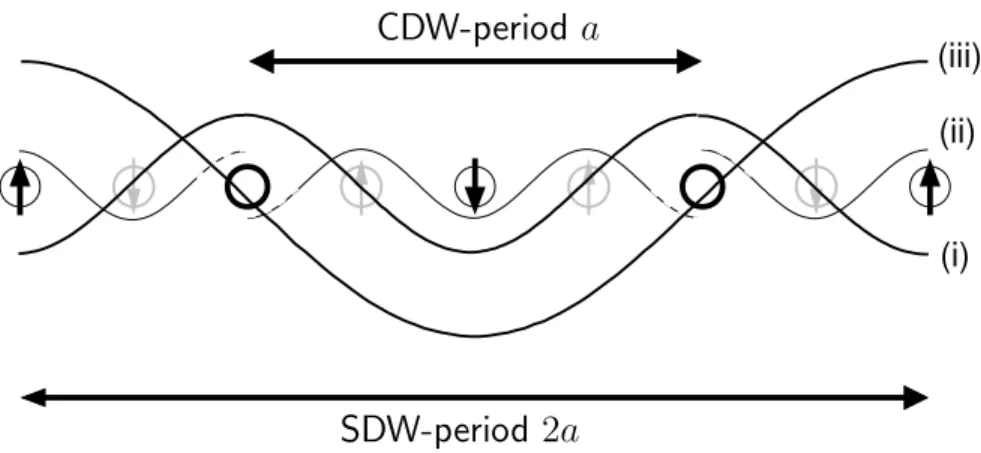
![Fig. B.3: Temperature vs doping phase diagram of the high-T c compound La 2−x Sr x CuO 4 ; from [KBB + 92].](https://thumb-eu.123doks.com/thumbv2/1library_info/3707964.1506244/14.918.464.741.80.452/fig-temperature-doping-phase-diagram-high-compound-cuo.webp)

